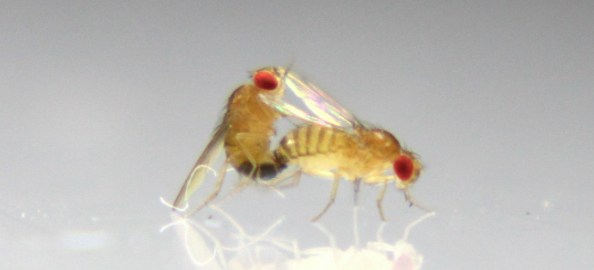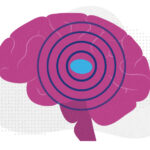Fruit flies’ love lives could clarify brain cells’ role in motivation

If you have children present, you might want to click out of this post. But if you want to understand motivation, you’ll want to know about the sexual behavior of fruit flies.
In the brain, motivational states are nature’s way of matching our behaviors to our needs and priorities. But motivation can go awry, and dysfunction of the brain’s motivation machinery may well underlie addiction and mood disorders, says Michael Crickmore, PhD, a researcher in the F.M. Kirby Neurobiology Center. “Basically, every behavior or mood disorder is a disorder of motivation,” he says.
It’s already known that brain cells that communicate via the chemical dopamine are important in motivation—and are also implicated in ADHD, depression, schizophrenia and addiction. But what exactly are these cells up to, and who are they talking to? That’s where fruit flies come in.
“We study motivation in a simple system that we can bash very hard,” says Crickmore.
Observing mating behavior in male fruit flies is an easy way to observe motivation. Moreover, the brain circuitry behind fly mating has already been characterized, thanks to the creature’s very small brain, which has only about 100,000 neurons (compare with our own 100 billion).
“If you really squint, you can see it,” says Crickmore.
Spying on flies
In their experiments, Crickmore and colleagues put males together with females, and watch what happens next. Like a security guard monitoring multiple cameras (see above video), they can spy on many trysts at once.
At first, they’ve found, males are highly motivated to mate, an activity that typically takes about 25 minutes. For the first 5 minutes, nothing can disengage them, even lethal stimuli like extremes of heat or cold. But then they become increasingly distractible. By 20 minutes, merely annoying stimuli are enough to make them terminate mating, and at 25 minutes, they stop on their own: once their reproductive fluid has been transferred, there’s little practical advantage to continuing.
They’ve lost their motivation.
The males are performing a cost/benefit analysis when confronted with danger, Crickmore explains. “They’re calibrating their mating activity.”
Micro-managing motivation
Through optogenetics, Crickmore’s team can manipulate the activity of handfuls of individual neurons and see how that changes mating duration. For example, when they stimulated groups of dopamine neurons, male flies mated for hours instead of the usual 25 minutes. “This is a result of heightened motivation,” Crickmore says. “More motivation means longer mating.”

In talking about his chosen research subject, Crickmore waxes philosophical. He cites philosopher Arthur Schopenhauer’s concept of The World as Will and Representation—“will” being the drive to engage with the world and “representation” being the sensory stimuli that produce that drive. In Crickmore’s view, the brain’s motivation circuitry acts as arbiter, helping the organism decide what to interact with. He also sees parallels between motivation and vitalism, an early scientific doctrine that held that living things contain a substance or spirit that sets them apart from inanimate objects.
“Now we can look at the neuronal circuits that generate motivation, and subject them to real mechanistic scrutiny,” he says. “With the new generation of neurogenetic tools, motivation becomes easier to study, and may eventually be demystified—as was the nature of life.”
Related Posts :
-

The thalamus: A potential therapeutic target for neurodevelopmental disorders
Years ago, as a neurology resident, Chinfei Chen, MD, PhD, cared for a 20-year-old woman who had experienced a very ...
-

Could peripheral neuropathy be stopped before it starts?
An increase in high-fat, high-fructose foods in people’s diets has contributed to a dramatic increase in type 2 diabetes. This, ...
-

Mutations during prenatal development may contribute to schizophrenia
Schizophrenia is known to have a genetic component, and variants in 10 genes have been identified as markedly increasing schizophrenia risk. ...
-

Delving into the causes of attention deficits: Childhood adversity, lost sleep, and dopamine
New research on the effects of adversity in childhood ties together stress, sleep loss, and attention deficits later in life. ...





